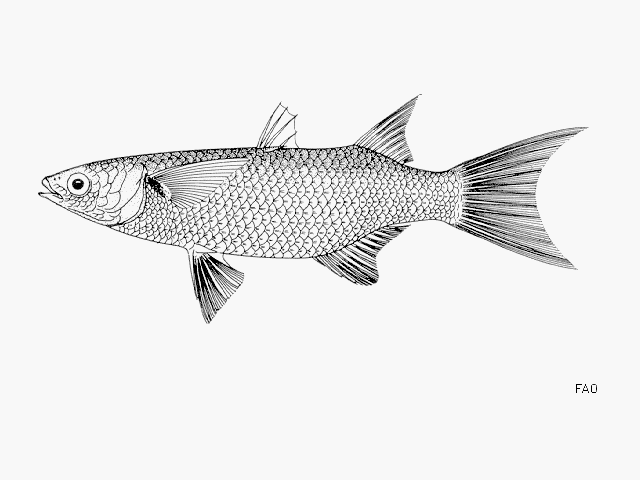|
Anal spines: 3-3; Anal soft rays: 10-12. Diagnosis: anal fin with at least 13 (usually 14) rays in total (usually III-11 in adults)(Ref. 81659), 10-11 anal soft rays (Ref. 57400). Scales on flanks cycloid; posterior end of maxilla weakly curved or almost straight; serrate, anteroventral edge of lachrymal weakly concave (Ref. 81659). 12-15 scales in an oblique, transverse series; colour of fins greyish-white; second dorsal, pectoral fins and anal fin distinctly falcate (Ref. 57400).
Description: body rather deep (Ref. 81659), elongate, compressed, reaching greatest depth at level of anal-fin origin (Ref. 57400). Head broad; interorbital space almost flat (Ref. 57400). Snout blunt (Ref. 81659), broad and rounded (length = half of width)(Ref. 57400). No adipose eyelid; upper lip not ornamented (Ref. 57400). Upper lip with outer row of well spaced teeth, usually unicuspid but may include some bicuspid teeth; up to ten inner rows of small, closer-set, bicuspid teeth may be present, usually well separated from outer tooth row, but inner rows not visible in some specimens; lower lip usually without teeth, sometimes with single row of minute, ciliiform teeth (Ref. 81659). Hind end of upper jaw reaching a vertical line passing between posterior nostril and anterior eye margin; maxillary pad visible below corner of mouth when closed (Ref. 57400). Scales cycloid, except for weakly ctenoid scales on dorsal and ventral parts of caudal peduncle, and distinctly ctenoid scales on ventral parts of abdomen and thorax; in specimens >40 mm SL most scales have single groove, but some predorsal scales may have 2 small grooves; 35-40 (usually 36-37) scales in longitudinal series (excluding scales on caudal fin base); 11.5-13.5 scale rows between pelvic and first dorsal fins; second dorsal fin with 10 (rarely 9) segmented rays; anal fin with 3 spines and 11 (rarely 10 or 12) segmented rays in adults (1st spine very short and usually hidden by overlying scales); usually 2 spines and 12 segmented rays in juveniles <30 mm SL (Ref. 81659). Origin of 1st dorsal fin equidistant from snout tip and caudal-fin base (Ref. 57400). Anterior rays of second dorsal and anal fins prolonged, forming a typical falcate lobe (Ref. 57400, 81659). Caudal fin broad, crescent-shaped; pectoral axillary process absent (or rudimentary)(Ref. 57400). Pectoral fin 80-100% of head length, with 1 short, unsegmented ray dorsally and 15-17 (usually 16) longer, segmented rays; pharyngobranchial organ usually with two valves, anteroventral valve a small, semi-lunate flap or reduced to very small, digitate process, posterodorsal valve a small fold, sometimes fimbriate, or may be vestigial; several pyloric caeca, perhaps 15-18, with bifurcations at distal tips (Ref. 81659).
Coloration: greyish or brownish olive dorsally; flanks silvery (Ref. 57400, 81659). Dorsal fins and caudal fin dusky; anal fin dusky except for whitish distal margin; pelvic fins pale (Ref. 81659). Pectoral fin grey, sometimes yellowish (Ref. 81659), with dark spot at origin (Ref. 57400, 81659). |
| Euryhaline, tolerating conditions varying from hypersaline to freshwater; favours sandy or muddy substrates (Ref. 81659). Very common in coastal lagoons and estuaries (Ref. 2683, 57400, 81659). Also caught in hypersaline environments (Ref. 57400) and freshwaters (Ref. 7399, 57400, 81659) several kilometres upstream in rivers (Ref. 81659). Feed on plankton and detritus (Ref. 28587). Oviparous, eggs are pelagic and non-adhesive (Ref. 205). Spawning may occur in lagoons or in the sea (Ref. 81659). Possibly reaches up to 500mm FL (Ref. 57400, 81659). |

